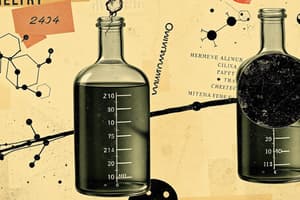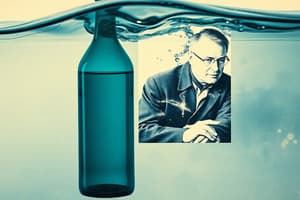Podcast
Questions and Answers
What is the largest peat swamp forest in the world, and what is causing it to be at risk?
What is the largest peat swamp forest in the world, and what is causing it to be at risk?
- Peatlands in Russia, due to overgrazing by livestock
- Peatlands in Canada, due to acid rain from industrial activities
- Peatlands in Indonesia, due to land degradation and loss of carbon to the atmosphere from draining and clearing for agriculture (correct)
- Peatlands in Malaysia, due to air pollution from industrial activities
What are the main sources of water, and what are some examples of anthropogenic impacts on water chemistry?
What are the main sources of water, and what are some examples of anthropogenic impacts on water chemistry?
- Main sources of water are oceans, rivers, and groundwater; anthropogenic impacts include volcanic activity and natural weathering
- Main sources of water are coastal zones, icebergs, and ground ice; anthropogenic impacts include deforestation and desertification
- Main sources of water are atmospheric water, inland seas, and glaciers; anthropogenic impacts include acid rain and high nitrite levels from fertilizers (correct)
- Main sources of water are wetlands, reservoirs, and estuaries; anthropogenic impacts include overfishing and oil spills
What are the main components of soils, and what are histosols?
What are the main components of soils, and what are histosols?
- Soils are composed of rocks, gravel, and sand; histosols are a type of mineral soil with high levels of nitrogen and phosphorus
- Soils are composed of organic matter, sand, and silt; histosols are a type of organic soil without permafrost (correct)
- Soils are composed of minerals, clay, and soil colloids; histosols are a type of mineral soil with permafrost
- Soils are composed of clay, humus, and silt; histosols are a type of organic soil with high levels of carbon and low oxygen content
What is the largest source of dissolved material in rivers?
What is the largest source of dissolved material in rivers?
What are the three types of water footprints included in the global water footprint?
What are the three types of water footprints included in the global water footprint?
What is the main risk associated with draining and clearing peatlands in Indonesia?
What is the main risk associated with draining and clearing peatlands in Indonesia?
What is the main cause of soil acidification?
What is the main cause of soil acidification?
What is the effect of soil pH on plant growth?
What is the effect of soil pH on plant growth?
What is the role of oxygen in redox reactions during respiration?
What is the role of oxygen in redox reactions during respiration?
What is the main cause of soil acidification?
What is the main cause of soil acidification?
What is the effect of nitrogen fertilizers and nitrification on soil pH?
What is the effect of nitrogen fertilizers and nitrification on soil pH?
What is the main reason for liming with limestone to increase soil pH?
What is the main reason for liming with limestone to increase soil pH?
Flashcards are hidden until you start studying
Study Notes
Water Chemistry, Sources, and Soil Characteristics
- Vegetation impacts water chemistry through evaporation, transpiration, decay of organic matter, and selective uptake of ions.
- Anthropogenic impacts on water chemistry include acid rain, landfill leachate, and high nitrite levels from fertilizers.
- Geology affects water chemistry, with about 60% of dissolved material in rivers coming from weathered rock.
- Lake formation can affect water chemistry through dilution and concentration, nutrient input, sedimentation, residence time, water circulation, pH, and alkalinity.
- Water sources include atmospheric water, oceans, inland seas, coastal zones, estuaries, rivers, reservoirs, lakes, wetlands, groundwater, soil water, glaciers, icebergs, and ground ice.
- The global water footprint includes green water, blue water, and grey water footprints.
- Main ions in water include anions and cations, such as chloride, sulphate, hydrogencarbonate, carbonate, calcium, sodium, magnesium, and potassium.
- Biogenous substances in water include silicon, nitrogen, and phosphorus, which are produced by living organisms.
- Soils are composed of minerals, clay, organic matter, and soil colloids, which are characterized by their size, surface area, and charge.
- Histosols are a type of organic soil without permafrost, with little profile development and accumulation of organic matter as the main soil-forming process.
- Peatlands in Indonesia are the largest peat swamp forest in the world and are at risk of land degradation, loss of carbon to the atmosphere, and air pollution due to draining and clearing for agriculture.
- In Malaysia, histosols cover 8% of the land area, mostly in coastal wetlands or just inland for mangroves, with 30% cleared for agriculture.
Soil Acidity, Redox Reactions, and Groundwater Discharge
- Groundwater discharge occurs through evaporation, effluent seepage, groundwater leakage, and abstraction for domestic, industrial, and agricultural use.
- Nitrogen deficiency in soil causes stunted plant growth and chlorosis of older leaves.
- Phosphate rock is a finite resource used 85% for fertilizer, and phosphorus deficiency causes anthocyanin in plants.
- Soil pH affects ion exchange capacity, plant availability of nutrients, and growth of plants and microbes.
- Soil acidification occurs from adding hydrogen ions from acid-forming processes, exchange of 2 hydrogen ions for a calcium ion, and aluminum cations absorbed more strongly than non-acidic cations.
- Acidity and aluminum mobilization occur when adsorbed hydrogen ions attack clay surfaces, releasing structural aluminum cations and exchanging with solution until in equilibrium.
- Acid soils cause aluminum toxicity, which restricts root growth and inhibits nutrient uptake, and molybdenum deficiency restricts symbiotic nitrogen fixation.
- Nitrogen fertilizers and nitrification cause soil acidification through ammonium and oxygen release, which also leaches nitrate and hydrogen ions.
- Acid rain from burning fossil fuels releases sulfur dioxide and nitrogen oxides gases, oxidizing to sulfuric and nitric acid returned to the soil in acid rain and dry deposition.
- Acid sulfate soils cause oxidation reactions when exposed to oxygen, and liming with limestone effectively increases soil pH.
- Determining lime requirement considers pH buffering capacity, initial soil pH and required change, depth of soil to ameliorate, and type of liming material used.
- Redox reactions involve transfer of electrons, with reduction gaining electrons or losing positive charge and oxidation losing electrons or gaining positive charge. Terminal electron acceptors during respiration are oxygen, and organic carbon is oxidized through aerobic respiration.
Soil Acidity, Redox Reactions, and Groundwater Discharge
- Groundwater discharge occurs through evaporation, effluent seepage, groundwater leakage, and abstraction for domestic, industrial, and agricultural use.
- Nitrogen deficiency in soil causes stunted plant growth and chlorosis of older leaves.
- Phosphate rock is a finite resource used 85% for fertilizer, and phosphorus deficiency causes anthocyanin in plants.
- Soil pH affects ion exchange capacity, plant availability of nutrients, and growth of plants and microbes.
- Soil acidification occurs from adding hydrogen ions from acid-forming processes, exchange of 2 hydrogen ions for a calcium ion, and aluminum cations absorbed more strongly than non-acidic cations.
- Acidity and aluminum mobilization occur when adsorbed hydrogen ions attack clay surfaces, releasing structural aluminum cations and exchanging with solution until in equilibrium.
- Acid soils cause aluminum toxicity, which restricts root growth and inhibits nutrient uptake, and molybdenum deficiency restricts symbiotic nitrogen fixation.
- Nitrogen fertilizers and nitrification cause soil acidification through ammonium and oxygen release, which also leaches nitrate and hydrogen ions.
- Acid rain from burning fossil fuels releases sulfur dioxide and nitrogen oxides gases, oxidizing to sulfuric and nitric acid returned to the soil in acid rain and dry deposition.
- Acid sulfate soils cause oxidation reactions when exposed to oxygen, and liming with limestone effectively increases soil pH.
- Determining lime requirement considers pH buffering capacity, initial soil pH and required change, depth of soil to ameliorate, and type of liming material used.
- Redox reactions involve transfer of electrons, with reduction gaining electrons or losing positive charge and oxidation losing electrons or gaining positive charge. Terminal electron acceptors during respiration are oxygen, and organic carbon is oxidized through aerobic respiration.
Studying That Suits You
Use AI to generate personalized quizzes and flashcards to suit your learning preferences.




